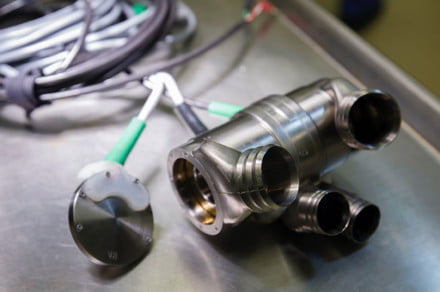[youtube https://www.youtube.com/watch?v=15XkJ60Fz0c?feature=oembed&w=100&h=100]
Until 3D bioprinting allows us to print fully functional organs to replace damaged or non-functioning ones, scientists and engineers have to explore alternatives. One intriguing concept being developed by researchers at the Oregon Health and Science University (OHSU) involves a titanium alloy-coated device which looks like a spare car part — but actually turns out to be a potentially life-saving artificial heart.
Its inventors hope that it could one day be the first permanent completely artificial heart, which could help save the lives of some of the approximately 75,000 Americans who die of heart failure each year.
Compared to other artificial heart designs, OHSU’s creation includes no valves and boasts a very simple design, which involves replacing the two ventricles of the human heart with a single titanium tube. This houses a hollow titanium alloy-coated hollow rod that moves back and forth, prompting the movement of blood to the lungs where it can be oxygenated, and continue its journey around the body. The finished model heart will be powered by a combined controller and rechargeable battery pack. In the short-term, users would carry this with them on a belt or in a backpack. Long-term, however, a smaller battery could be implanted beneath a patient’s skin and recharged from the outside.
OHSU/Kristyna Wentz-Graff
“Considering the human heart beats 14 million times a year, it’s crucial that an artificial heart is durable and robust,” Sanjiv Kaul, who is working on the design, said in a statement. “The simple, efficient design of our total artificial heart makes its potential for failure very low.”
The project started out as an invention by the now-retired Richard Wampler. OHSU then created a spinoff company named OregonHeart in 2014, which developed a further two versions of the device tested in animals at the University of Louisville. The first of these models was larger, to demonstrate the design’s proof of principle, and was implanted in cows. The second was the right size for humans and was tested in sheep.
OregonHeart ultimately ceased operations, but OHSU is continuing work on the project in-house. Researchers working on the project plan to carry out more studies involving sheep. If these tests go as planned, they will they request federal permission to run clinical trials on humans using the device.
While it may look unorthodox if this creation works as hoped it could be a game-changer for transplant surgery.
Editors’ Recommendations
- A ’bionic’ larynx sounds far more natural than regular artificial voice boxes
- Science of the Lambs: We can now grow human cells in sheep
- Scientists have figured out how to make wood even stronger than steel
- Truly creative A.I. is just around the corner. Here’s why that’s a big deal
- Blink to click? Nanotube-coated tissue paper sensor can track eyeball movement

